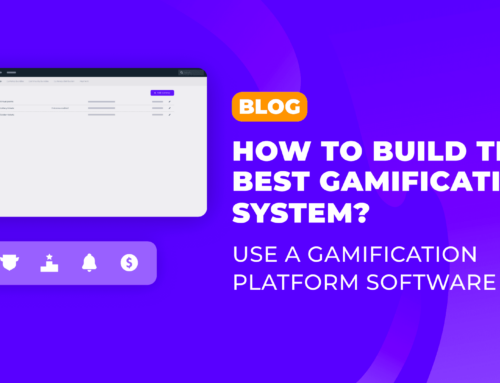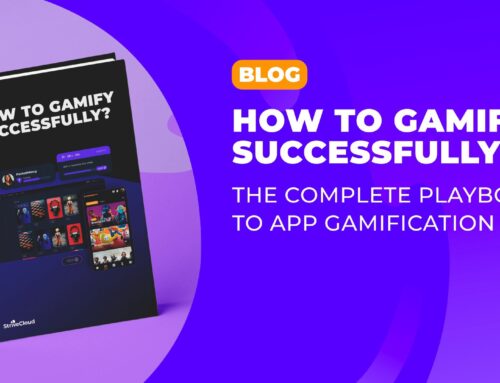10 tried & tested ways to increase banking app engagement
Banking apps are the third most-used apps after social media and weather apps. However, banks and product managers are having a hard time keeping up a good retention rate. Research by Leanplum and Liftoff states that after one day of signing up for a financial app, only 34% of users stay. Add another week to that, and the number drops to 15%. A total of 90 days later only 3.4% is left. With app engagement this low, creating a better user experience has become a major priority for banks.
So what are some actionable things you can do? We’ve put together 10 hacks you can try to supercharge your app engagement!
Here’s what you’ll learn:
Boost app engagement with gamification for apps
Gamification is the use of game elements and psychology in a non-game context. Essentially, it draws from what makes a game fun and engaging, and puts it into apps to get users hooked. Game elements such as leaderboards and progress bars can drive app engagement by responding to a user’s inherent motivations and desires.
Monobank, a leading neobank from Ukraine uses gamification for apps to boost active user engagement. Its users can have fun and earn rewards while using the banks’ services. The bank has a badge reward system in place to reward actions like using your card in different cities or spending in certain categories. Along with the badges, users can earn points that they can later redeem for branded clothing. Lastly, the game offers some in-app games and hidden easter eggs.
Want to learn more about gamification? Here’s our “what is gamification” page to help you get started!
StriveCloud created a plug-in gamification tool built for retention. It helps product managers add a layer of gamification to their web and mobile apps to drive user activity and app engagement. When used correctly it can boost app usage by 54%!
With this gamification tool, you can gamify any data point to change user behaviors, without having to hire a product studio. Here’s what StriveCloud’s plug-in gamification tool could do for you:
- Plug-in your mobile or web app and choose what metrics drive the user journey forward
- Set personalized milestones and challenges to trigger user activation
- Visualize user progress with progress bars to fuel their motivation
- Reward active participation and app engagement to keep users coming back
- Target users with in-app messages based on previous interactions and behavior
Want to build an app that keeps your users coming back? Learn more about our plug-in gamification tool!
Re-engage users with personalized push notifications
If you use notifications correctly, it will activate users when they’re most likely to engage. According to Localytics, notifications can increase in-app engagement by 88%. Users that enable push notifications are nearly 3 times more likely to return to your app within 30 days.
Axis Bank from India put this to the test when they created personalized web notifications, based on online user behavior. They only targeted specific customers that had shown interest in their credit card service, instead of reaching out to every single customer. Among the users who received the notification, a whopping 36% became positive leads.
Personalize the user experience for higher app retention
Every user will have different goals, and therefore different use cases within your app. For banking apps that could be one user being focused on saving, and another user on investing. It seems obvious these two would want a different experience, tailored to their goals. In fact, 72% of consumers confirm this.
Once you understand behavioral data, you can use it to improve the user experience. For instance, you can use personalized reminders to encourage savings or market alerts for investments. It all depends on what your users need from you.
Create better onboarding to slash churn
Poor onboarding is the number one cause of customer churn! In fact, 80% of people have deleted an app because they didn’t know how to use it.
The key to great onboarding is to keep it simple. Give the users instructions step by step, but leave them in control. You can set milestones, use progress bars or checklists, create product walkthroughs, and many more things. However, simplicity is key. Don’t overwhelm your customer. Here’s a great example from the couponing extension Honey.
Use in-app messaging to guide your users to value
In-app messages improve app engagement by 26%. Highly used apps do even better with an increase in-app engagement of 44%. You can use them to help users discover new features or use cases for your app. Or maybe you want to share your latest updates, promote relevant offers, or deliver proactive support?
The possibilities are endless. In-app messages can be hyper-targeted without forcing the user to leave the app. It can simply boost interaction in the right place, at the right time.
Give users a head start to trigger their motivation
When a user needs to fulfill a certain set of tasks to get value from your app, you can motivate them by giving a head start. For instance, when a user needs to fill out a form, you can already add the information you know about them.
Additionally, you could use it in onboarding like the payment app PayPal does. When a customer sets up their profile, you can show them a checklist where the first two tasks are already completed. Even if those tasks are as simple as opening the app and signing up! Doing so creates something called the “endowed progress” effect.
Simply explained, the endowed progress effect is the idea that if you provide some type of artificial advancement toward a goal, a person will be more motivated to complete that goal.
A lot of banking apps are leveraging the power of social to improve app engagement. Some banks are sharing financial tips on their feeds, while others have an active forum to debate on finance. The great thing is you get to speak with your users directly.
According to amity, in-app communities makes users 2.7 times more likely to stay due to a sense of community and belonging. Users not only feel more involved but are also 4 times more likely to refer their friends.
Incentivize user behavior through variable rewards
Reward your users for behaviors that support your business goals. This creates positive reinforcement in the users’ mind and conditions them to do it again. It’s the same theory used in online games and slot machines to keep users actively engaged. Google, Facebook, and Twitter all have been using these techniques, often referred to as Skinnerian marketing.
Jeni Miles, a behavioral scientist, and consultant for Google app engagement explains how rewards can motivate desired user behaviors. You can reward users through badges, points, or freebies. However, focusing on other types of rewards such as exclusive access and status is more effective over the long term and turns your app into a habit-forming product.
Allow user feedback & interaction
Sometimes, allowing users to give their opinion on their experience gives you all the information you need to improve your app. It also gives users the sense of being heard, which is becoming increasingly important among digital natives.
In-app feedback often has higher response rates and gives you context-based feedback. You can ask for ratings, surveys to discover key metrics about your app. What is your Net Promotor Score? How did your users find you? Above all, consider the overall experience and don’t overwhelm your users with questions.
Learn and improve
It’s important to keep working on your app to create better user experiences. There are many principles you can apply here. For instance, start with a minimum viable product, and then build new features around it. With every iteration you learn, your app improves and your users become more engaged.
Use A/B testing to test different approaches for your audience. Maybe you can even test out this top 10 list to see how it improves your app engagement?
Key takeaways
In 2020 the usage of digital banking apps skyrocketed. However, lots of product managers in banks and other financial institutions still struggle to keep their users engaged. Luckily, there are lots of things you can do to pimp your user experience and build a product that gets users hooked!
Here are the key learnings:
Find what triggers your users
A trigger puts your users into action. Figuring out how to personalize and target these triggers is often a make or break step within your user experience. You can use in-app messaging, smart push notifications, or give your users a head start in your onboarding.
Put your users into action
What is the simplest action a user can take to get value from your app? On Facebook, this would be scrolling in the anticipation of a cool post. To succeed here your user needs to have two things: motivation and ability. Therefore, simplifying your action with step-by-step instructions, and boosting motivation through rewards is a great way to enhance user participation.
Build anticipation through variable rewards
The secret to app engagement lies in variable rewards. It helps you to turn motivation for a reward, into a deep intrinsic desire. Research shows dopamine goes through the roof when the brain is expecting a reward. Making those rewards variable puts users into some kind of hunting state similar to a slot machine.
Mechanisms like a badge reward system and leaderboards build on inherent desires for status, achievement, and progress.
Simplify the users’ investment
An investment from users is often a combination of time, data, effort, social capital or money. As a user, however, you don’t want to do things that don’t add value to your experience. However, it is proven that users who do this kind of investment are more likely to return.
The key is to derive value from users’ investments by using it to improve future triggers, actions, and rewards! The more someone will use your app, the better their experience will become!


